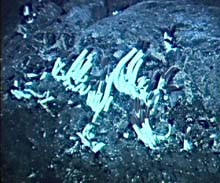
These tubeworms were spotted on the Galapagos Rift expedition. They are frequently found on vent communities in the Pacific ocean. Click image for larger view.
Galapagos Rift
May 24 - June 4, 2002
To mark the 25th anniversary of the historic discovery of deep-sea hydrothermal vents at the Galápagos Rift, a team of scientists from NOAA's Pacific Marine Environmental Laboratory ![]() , Woods Hole Oceanographic Institution
, Woods Hole Oceanographic Institution ![]() and several universities revisited the Galapagos Rift.
and several universities revisited the Galapagos Rift.
During this expedition, the team studied cracks in the ocean floor where underwater hot springs gush shimmering, mineral-rich fluids into the cold, dark depths. These cracks in the ocean floor, called vents, brim with extraordinary, unexpected life. It was here, in total darkness, where scientists made their stunning discovery, 25 years ago, that forever changed our understanding of our planet and life on it.
Background information for this exploration can be found on the left side of the page. Daily updates are included below. More detailed logs and summaries of exploration activities can be found on the right.
Updates & Logs
Click images or links below for detailed mission logs.
June 4 Log - Mission Summary The ocean exploration cruise to the Galapagos Rift, from May 24 to June 4, resulted in major discoveries at the site of the famous Rose Garden hydrothermal vent. One objective of the cruise was to compare the present state of site to the way it was in 1977. Initial results of the cruise strongly support observations that the Rose Garden no longer exists. The vent field has apparently been covered by a lava flow that overran the site, probably within the past ten years. As the team searched the region in the vicinity of the Rose Garden they discovered a new community of hydrothermal animals that seem likely to be the nascent progenitors of a reborn Rose Garden. Aptly, the new site has been named Rosebud. Rosebud appears to be a relatively young site and home to a wide variety of invertebrate vent-specific organisms including the famous Riftia tubeworms and large mussels and clams. The Rosebud discovery dramatically underscores the dynamic nature of deep sea floor processes, especially in volcanically active areas.

June 1 The team observed a submerged volcano split in half where the plates of the earth's surface spread apart. They also found large clams and mussels, not unusual in hydrothermal vent communities.

May 31 How long do vent communities survive? The team is learning that the life on the axial ridge is quite dynamic on the geological time scale, and even on our time scale. A thriving vent community rich in abundance only decades ago, is gone, and a smaller, new one is found.

May 30 Steaming west from the “Rose Bud” site, the crew of Atlantis examines new areas of the Galapagos Rift hoping to find high temperature velocity vents. Many biological species are collected for later examination, and water samples are taken to look for unique mineral components.

May 29 During the evening, data brought back from ABE and CTD tows revealed temperature anomolies worth investigating. After being extensively mapped by ABE the Alvin dove to investigate. Glassy lava formations suggest an area of recent vent activity.

May 28 The Rose Garden still has not been found. Scientists are beginning to speculate that this area, discovered in 1979, has since been covered by lava flow. During one of Alvin's dives a new area named “Rose Bud” is explored.
![]() You can also watch a video of deep sea ocean life. (mp4, 723 KB)
You can also watch a video of deep sea ocean life. (mp4, 723 KB)

May 27 The search for the Rose Garden area continues. Dive teams have spotted a new vent area, populated with mussels, tube worms, and other creatures, covering about 50 square meters. ABE also detected warm water sources, and Alvin was dispatched there to investigate, where it found a vent.

May 26 Alvin dive operations begin according to plan. Alvin Expedition Coordinator Pat Hickey piloted the submersible, with Co-Chief Scientists Steve Hammond of NOAA, and Tim Shank of WHOI making the dive. After a lengthy search, the crew found the beginnings of a recently created lava field.

May 25 The day began with safety drills for everyone on the mission. The R/V Atlantis continues to transit toward the dive sites and the Galapagos Rift. Pre-operation briefings are held.
![]() Watch a close encounter with a curious Galapagos sea lion. (mp4, 4.6 MB)
Watch a close encounter with a curious Galapagos sea lion. (mp4, 4.6 MB)

May 24 The Galapagos team has reached the islands and is boarding the research vessel to begin their exploration of the deepsea rift.
![]() See what the Atlantis looks like in port. (mp4, 4.1 MB)
See what the Atlantis looks like in port. (mp4, 4.1 MB)
Sign up for the Ocean Explorer E-mail Update List.















